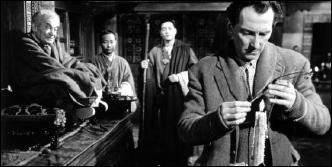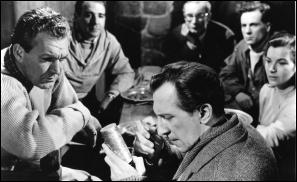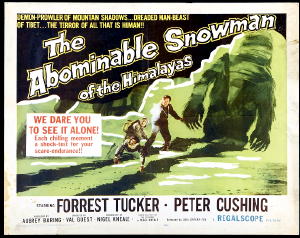Sat 17 May 2014
A Movie Review by Jonathan Lewis: THE ABOMINABLE SNOWMAN (1957).
Posted by Steve under Horror movies , Reviews[11] Comments
THE ABOMINABLE SNOWMAN. Hammer Films, UK, 1957. Released in the United States as The Abominable Snowman of the Himalayas. Forrest Tucker, Peter Cushing, Maureen Connell, Richard Wattis, Robert Brown, Michael Brill, Wolfe Morris, Arnold Marlé, Anthony Chinn. Screenplay: Nigel Kneale, based on his 1955 BBC teleplay entitled The Creature. Director: Val Guest.
Running just over 90 minutes, The Abominable Snowman stars Peter Cushing (Dracula, The Mummy) as an English botanist on an ill-fated Himalayan expedition to find the mythical Yeti.
The film is, in many ways, more of a psychological thriller than a traditional horror film. Both the claustrophobic isolation of the Himalayas and the tension between members of the expedition party play far more prominent roles in the narrative than do the Yeti, whom we see only briefly toward the end of the film.
The plot is relatively straightforward. John Rollison (Cushing) and his wife, Helen (Maureen Connell) are living and working in the Tibetan monastery, Rong-ruk. They are guests of the enigmatic Lama (Arnold Marlé) who seems to know a lot more than he lets on. Although Rollison isn’t in the best physical shape in the world, he insists upon joining the expedition of the loud-mouthed American guide and showman, Tom Friend (Forrest Tucker). Helen isn’t happy about the arrangement.
The party’s goal is find the Yeti. But Friend and his associates have different goals than Rollison. Friend, a conman and a fraud, wants to capture a Yeti alive and sell it to a carnival show. Rollison, more pure of heart, wants to study and learn about the Yeti.
He posits both that Yeti are intelligent, sentient creatures and that they are merely biding their time on Earth, hidden up in the Himalayan peaks, until man destroys himself. They also have quasi-hypnotic powers.
The doomed explorers do manage to find and to kill a Yeti, setting into motion a chain of events that leave Rollison the sole surviving member of the expeditionary party. The most important scene in the movie occurs in an ice cave when Rollison finally encounters live Yeti. He makes eye contact with one of them and realizes that his theory about Yeti intelligence was indeed correct.
The film, a product of the anxieties of the Atomic Age, imparts a fairly obvious message about how man’s hubris may end up being his downfall. The theme of what it means to be civilized also features prominently in the film. This is notable given the fact that the late 1950s were the beginning of the end for British imperialism.
While I would not go so far as to say that The Abominable Snowman is a particularly notable film, I found the story about how the Yeti will be man’s successors to be thought provoking. Unfortunately, the production quality now seems considerably dated.
The film’s pacing can feel a bit slow. Indeed, unlike The Mummy (also from Hammer films two years later and reviewed here earlier on this blog), which remains an absolute gem, The Abominable Snowman, while not a bad film, really doesn’t stand up to the test of time. Perhaps that is one reason why, in late 2013, Hammer Films announced that they are planning to remake this oft-neglected British cult classic.
In conclusion, The Abominable Snowman is certainly worth watching at least once, if only for the ominous Eastern-themed music, bells, and chants that provide the film with a strong fosters a sense of both wonder and of impending doom. The monastery setting, which features considerably in the movie, is also visually stunning. It’s a reminder that the film was meant to transport the viewer into a different realm of existence and human understanding.
While I probably won’t watch the 1957 version again any time soon, I’m quite looking forward to seeing how the forthcoming remake turns out. I only hope the filmmakers do make it more of a psychological thriller than a creature feature.




May 18th, 2014 at 7:50 am
I rate it slightly more highly than you do. It is slower and, for the want of a better word, more chatty than a lot of Hammer’s features of that time. Guest and Kneale’s other team up at around the same time, QUATERMASS II, is much more obviously cinematic. This is more of a character piece, with Cushing’s haunted scientist (in the original TV play he is a widower, but Hammer wanted a female character, so she was revived for the movie) versus the crass, fortune hunting Tucker. The true nature of the creatures is only slowly revealed, with Cushing finally realising that the human race rather than the Yeti may be the ones who are on the verge of extinction. It’s much more of a dramatic reveal than simply him having his theories confirmed. The climactic scenes on the side of the mountain are plainly a set, but it is a good set, and to be honest the focus of the movie is always the dialogue and characters rather than the spectacle. I remain a little sceptical about the remake. The original script was making use of lots of contemporary news stories about the Yeti, whilst a modern version is going to feel rather dated.
May 18th, 2014 at 8:09 am
You’re most certainly correct regarding Cushing’s realization about the true nature of the Yeti. It is, as you say, a dramatic reveal. And one that occurs, in part, as a result of the tension between the two main characters.
I think that the modern version will work if they gave a good advertising/PR campaign. If audiences are familiar with the Yeti “legend” prior to going to see the film and are piqued by it, the film will work. Of course, they will need a good product.
May 18th, 2014 at 8:39 am
Yes, a good ad campaign can do a heck of a lot to sell a movie. I remember reading how someone involved in the Disney’s 90’s adventure movie THE ROCKETEER claimed that one of the reasons that the movie flopped was because the frankly beautiful art-deco styled ad campaign was selling it to the wrong audience. They should have been trying to entice young kids with the promise of action and adventure, but instead they were pitching it to their parents.
The contemporary ads for this movie are hilarious, in that they portray it as some sort of horror extravaganza (“It was too terrible to bring back! Don’t see it alone!!”) rather than the thoughtful movie that it actually is. Also, the fact that they changed the title for the US release always cracks me up. They added “Of the Himalayas”…did they seriously think that the audience were going to get it confused with, say “The Abominable Snowman of Detroit”?
May 18th, 2014 at 8:55 am
Maybe it was some movie executive who thought Americans needed an extra geographical reference! It just seems silly to me.
The trailer for the film really does make it sound like it’s going to be some sort of really over-the-top thrills and chills horror film with special effects and blood — like a 60s-70s Hammer Film — not the relatively tame psychological thrilled that it is.
I remember reading somewhere that the outdoor scenes were filmed in the Pyrenees. Not sure if that is accurate or not. I watched it on a VHS copy I now own and it didn’t have the behind-the-scenes extras that the DVD copy apparently does
May 18th, 2014 at 9:31 am
Yes, they had a ten day second unit shoot at La Mongie in the French Pyrenees. I remember Peter Cushing in a TV interview laughingly bemoaning the fact that none of the actors got to go!
It came out just after CURSE OF FRANKENSTEIN, which probably didn’t do it any favours at the time. I came across it many, many years ago as one half of a Saturday night horror double bill on TV, and really enjoyed it. I was a kid at the time, with no real preconceptions about the movie, which might have helped.
May 18th, 2014 at 6:13 pm
I haven’t been able to find that many other film about the Yeti. I guess the Yeti are one of the oft-forgotten, neglected monsters of horror cinema
May 19th, 2014 at 3:05 am
I found it intelligent but unexciting, which (given that back in the back-when, Horror Movies were only shown on local TV late at night) was the kiss of snooze for me.
May 19th, 2014 at 3:35 am
“intelligent but unexciting” is very apt
May 19th, 2014 at 1:33 pm
Yeah, it falls much more into the science-fiction genre than the horror one. QUATERMASS II and X THE UNKNOWN, made by Hammer at about the same time, both have intelligent sci-fi ideas in them. However, they both have a streak of visceral nastiness that means they have one foot in the horror camp. They both have more than one ‘Euurrggghh’ moment in them, which is totally missing in ABOMINABLE SNOWMAN.
May 19th, 2014 at 7:55 pm
You have to expect intelligent SF from Nigel Kneale, and as you say this is no creature feature Like several good films of television serials from the time this is thoughtful but low budget, but like The Crawling Eye, the Quatermass films, and Andromeda Breakthrough this is thought provoking thanks to Kneale.
May 20th, 2014 at 2:29 am
Nigel Kneale was certainly prolific. And his version of 1984 was a masterpiece, way ahead of its time. But I am biased. I’ve always enjoyed Peter Cushing and Donald Pleasence.